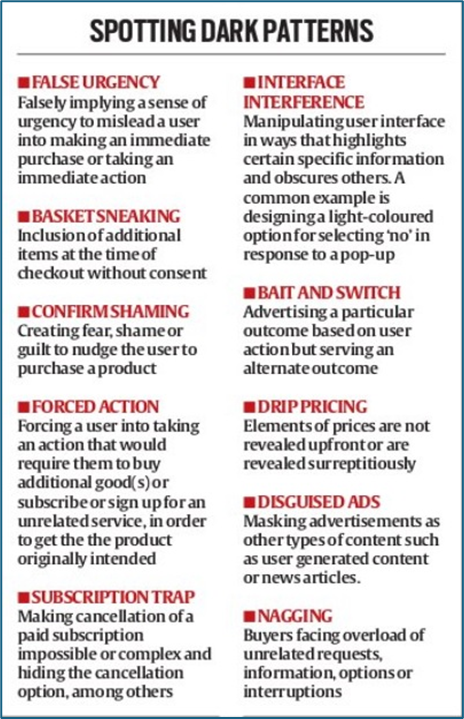Why in news?
The Advertising Standards Council of India (ASCI), in collaboration with Parallel, a product design studio, recently released a report focusing on the prevalence of deceptive patterns in leading Indian apps.
This study highlighted the use of one or more of 12 deceptive/dark patterns in most of these apps.
What’s in today’s article?
- Dark pattern – About, examples, regulation in India
- Dark patterns and digitally conscious products
Dark Patterns
- About
- Dark patterns refer to deceptive design techniques used in user interfaces to manipulate or deceive users into taking certain actions or making specific choices online.
- Such patterns are unethical user interface designs that deliberately make Internet experience harder or even exploit the users.
- These patterns exploit cognitive biases and behavioural tendencies to trick or mislead users, often for the benefit of the platform or business implementing them.
- These tricks can include creating a false sense of urgency, making people feel bad for not doing something, forcing them to take certain actions, trapping them into subscriptions, or constantly bothering them.
- Examples
- Social media companies and Big Tech firms such as Apple, Amazon, Skype, Facebook, LinkedIn, Microsoft, and Google use dark or deceptive patterns to downgrade the user experience to their advantage.
- Amazon
- It came under fire in the EU for its confusing, multi-step cancellation process for the Amazon Prime subscription.
- LinkedIn
- LinkedIn users often receive unsolicited, sponsored messages from influencers.
- Disabling this option is a difficult process with multiple steps that requires users to be familiar with the platform controls.
- Types
- Regulation of dark patterns in India
- In September 2023, Department of Consumer Affairs has sought public comments on Draft Guidelines for Prevention and Regulation of Dark Patterns.
- The objective was to clearly identify and define tactics as dark patterns so that the Ministry of Consumer Affairs can act against platforms indulging in this under Section 18 of the Consumer Protection Act, 2019.
- Advertising Standards Council of India (ASCI), a self-regulatory body of the advertising industry in India, recently said that it wants to expand its code to address concerns around dark patterns in digital advertising.
Dark patterns and digitally conscious products
- About the news
- The ASCI study highlights several deceptive patterns used by Indian apps to manipulate users.
- One such pattern is "Interface Interference," where apps use contrasting colors to draw attention to certain options while blending other parts of the screen, subtly steering users toward a specific choice.
- The study found that over 45% of leading Indian apps use this tactic.
- Another deceptive pattern is "Confirm Shaming," where apps use guilt or social pressure to influence user decisions.
- For example, an app might offer choices like "Upgrade now" or "I don’t want a smarter software," implying that choosing not to upgrade is foolish.
- A third example is "Basket Sneaking," where apps add unwanted items to a user's shopping cart, such as a charity donation, without explicit consent, requiring users to actively remove it if they do not wish to contribute.
- These examples illustrate how apps manipulate user behavior through deceptive design tactics.
- Other types
- The report identifies 12 deceptive patterns used in Indian apps, including the previously mentioned Interface Interference, Confirm Shaming, and Basket Sneaking.
- Other notable patterns are:
- Privacy Deception, where users are tricked into sharing more personal data than intended;
- Drip Pricing, where additional fees are gradually revealed during the purchase process; and
- Subscription Trap, where users are led into recurring subscriptions without fully understanding the commitment.
- Significance
- The study is significant as it raises awareness among marketers about these deceptive patterns, which could unintentionally be incorporated into app interfaces.
- It emphasizes the importance for brands with digital interfaces to review ASCI's guidelines and those from the Department of Consumer Affairs.
- As a practical step, marketers can use resources like the Conscious Patterns website to test their apps and receive a "conscious score," helping them balance business needs with user protection.
- The report also stresses that both marketers and designers need to prioritize ethical design practices, as the responsibility for app interfaces often lies with specialist designers rather than marketers.
- This awareness is crucial in the evolving digital landscape.










